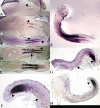Characterization of muscle-regulatory gene, MyoD, from flounder (Paralichthys olivaceus) and analysis of its expression patterns during embryogenesis
- PMID: 16362809
- PMCID: PMC4271811
- DOI: 10.1007/s10126-005-5042-0
Characterization of muscle-regulatory gene, MyoD, from flounder (Paralichthys olivaceus) and analysis of its expression patterns during embryogenesis
Abstract
Specification and differentiation of skeletal muscle cells are driven by the activity of genes encoding members of the myogenic regulatory factors (MRFs). In vertebrates, the MRF family includes MyoD, Myf5, myogenin, and MRF4. The MRFs are capable of converting a variety of nonmuscle cells into myoblasts and myotubes. To better understand their roles in fish muscle development, we isolated the MyoD gene from flounder (Paralichthys olivaceus) and analyzed its structure and patterns of expression. Sequence analysis showed that flounder MyoD shared a structure similar to that of vertebrate MRFs with three exons and two introns, and its protein contained a highly conserved basic helix-loop-helix domain (bHLH). Comparison of sequences revealed that flounder MyoD was highly conserved with other fish MyoD genes. Sequence alignment and phylogenetic analysis indicated that flounder MyoD, seabream (Sparus aurata) MyoD1, takifugu (Takifugu rubripes) MyoD, and tilapia (Oreochromis aureus) MyoD were more likely to be homologous genes. Flounder MyoD expression was first detected as two rows of presomitic cells in the segmental plate. From somitogenesis, MyoD transcripts were present in the adaxial cells that give rise to slow muscles and the lateral somitic cells that give rise to fast muscles. After 30 somites formed, MyoD expression decreased in the somites except the caudal somites, coincident with somite maturation. In the hatching stage, MyoD was expressed in other muscle cells and caudal somites. It was detected only in muscle in the growing fish.
Figures






Similar articles
-
Differential expression of two MyoD genes in fast and slow muscles of gilthead seabream ( Sparus aurata).Dev Genes Evol. 2002 Jun;212(5):207-17. doi: 10.1007/s00427-002-0224-5. Epub 2002 Apr 24. Dev Genes Evol. 2002. PMID: 12070611
-
Cloning and expression analysis of myogenin from flounder (Paralichthys olivaceus) and promoter analysis of muscle-specific expression.Comp Biochem Physiol B Biochem Mol Biol. 2007 May;147(1):135-45. doi: 10.1016/j.cbpb.2007.01.012. Epub 2007 Feb 1. Comp Biochem Physiol B Biochem Mol Biol. 2007. PMID: 17336560
-
Molecular structure and expression patterns of flounder (Paralichthys olivaceus) Myf-5, a myogenic regulatory factor.Comp Biochem Physiol B Biochem Mol Biol. 2006 Oct;145(2):204-13. doi: 10.1016/j.cbpb.2006.07.008. Epub 2006 Aug 1. Comp Biochem Physiol B Biochem Mol Biol. 2006. PMID: 16963299
-
Determination versus differentiation and the MyoD family of transcription factors.Biochem Cell Biol. 1995 Sep-Oct;73(9-10):723-32. doi: 10.1139/o95-080. Biochem Cell Biol. 1995. PMID: 8714693 Review.
-
Myogenic regulatory factors and the specification of muscle progenitors in vertebrate embryos.Annu Rev Cell Dev Biol. 2002;18:747-83. doi: 10.1146/annurev.cellbio.18.012502.105758. Epub 2002 Apr 2. Annu Rev Cell Dev Biol. 2002. PMID: 12142270 Review.
Cited by
-
A new pattern of primordial germ cell migration in olive flounder (Paralichthys olivaceus) identified using nanos3.Dev Genes Evol. 2015 Jul;225(4):195-206. doi: 10.1007/s00427-015-0503-6. Epub 2015 May 30. Dev Genes Evol. 2015. PMID: 26025098
-
Regulation of skeletal muscle differentiation in fibroblasts by exogenous MyoD gene in vitro and in vivo.Mol Cell Biochem. 2007 Aug;302(1-2):233-9. doi: 10.1007/s11010-007-9446-1. Epub 2007 Apr 6. Mol Cell Biochem. 2007. PMID: 17415623
-
Expression profiles and transcript properties of fast-twitch and slow-twitch muscles in a deep-sea highly migratory fish, Pseudocaranx dentex.PeerJ. 2022 Mar 30;10:e12720. doi: 10.7717/peerj.12720. eCollection 2022. PeerJ. 2022. PMID: 35378928 Free PMC article.
-
Recombination-activating gene 1 and 2 (RAG1 and RAG2) in flounder (Paralichthys olivaceus).J Biosci. 2014 Dec;39(5):849-58. doi: 10.1007/s12038-014-9469-1. J Biosci. 2014. PMID: 25431413
-
Differentiation and Maturation of Muscle and Fat Cells in Cultivated Seafood: Lessons from Developmental Biology.Mar Biotechnol (NY). 2023 Feb;25(1):1-29. doi: 10.1007/s10126-022-10174-4. Epub 2022 Nov 14. Mar Biotechnol (NY). 2023. PMID: 36374393 Free PMC article. Review.
References
-
- Blackwell T, Weintraub H. Differences and similarities in DNA-binding preferences of MyoD and E2A protein complexes revealed by binding site selection. Science. 1990;250:1104–1110. - PubMed
-
- Braun T, Bober E, Rudnicki MA, Jaenisch R, Arnold HH. MyoD expression marks the onset of skeletal myogenesis in homouzygous Myf5 mutant mice. Development. 1994;120:3083–3092. - PubMed
Publication types
MeSH terms
Substances
Associated data
- Actions
LinkOut - more resources
Full Text Sources
Miscellaneous
